高中英语时态知识点总结
- 格式:doc
- 大小:29.50 KB
- 文档页数:11
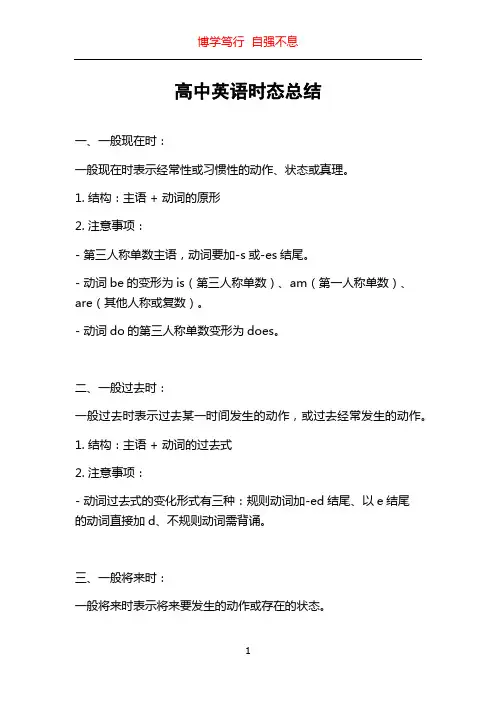
高中英语时态总结一、一般现在时:一般现在时表示经常性或习惯性的动作、状态或真理。
1. 结构:主语 + 动词的原形2. 注意事项:- 第三人称单数主语,动词要加-s或-es结尾。
- 动词be的变形为is(第三人称单数)、am(第一人称单数)、are(其他人称或复数)。
- 动词do的第三人称单数变形为does。
二、一般过去时:一般过去时表示过去某一时间发生的动作,或过去经常发生的动作。
1. 结构:主语 + 动词的过去式2. 注意事项:- 动词过去式的变化形式有三种:规则动词加-ed结尾、以e结尾的动词直接加d、不规则动词需背诵。
三、一般将来时:一般将来时表示将来要发生的动作或存在的状态。
1. 结构:主语 + will + 动词的原形2. 注意事项:- 当主语为第一人称时,可用shall代替will。
- 当表示将来的时间副词或状语连用时,将来时常和动词的原形连用。
四、现在进行时:现在进行时表示现在正在发生的动作。
1. 结构:主语 + am/is/are + 动词的ing形式2. 注意事项:- 动词-ing形式的构成规则为动词原形结尾加-ing。
- 动词末尾的e需去掉,再加-ing。
- 重读闭音节,末尾只有一个辅音字母时,应将末尾辅音字母双写,再加-ing。
五、过去进行时:过去进行时表示过去某一时间正在进行的动作。
1. 结构:主语 + was/were + 动词的ing形式2. 注意事项:- 动词-ing形式的构成规则同现在进行时。
- 句中使用过去进行时时,一般还需要使用表状态动词的动词-ing 形式。
六、将来进行时:将来进行时表示将来某一时间正在进行的动作。
1. 结构:主语 + will be + 动词的ing形式2. 注意事项:- 动词-ing形式的构成规则同现在进行时。
七、一般过去将来时:一般过去将来时表示过去的某个过去时间点本来要发生的事情,但实际上未发生。
1. 结构:主语 + would + 动词的原形2. 注意事项:- would在句中只表示动词的一种形式,无人称和数的变化。
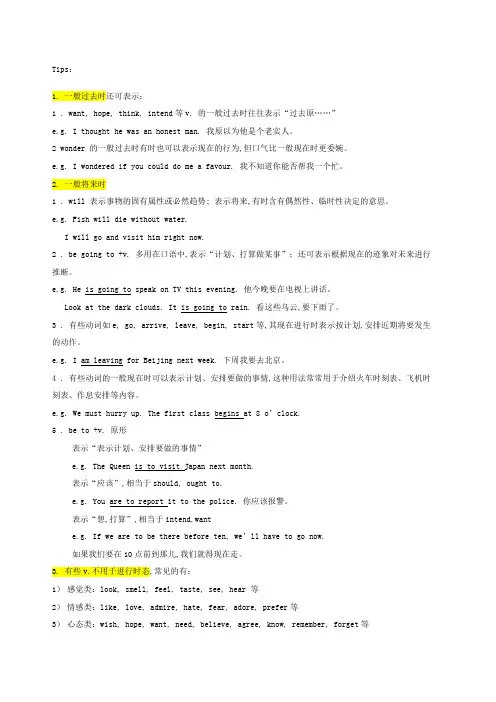
Tips:1. 一般过去时还可表示:1 . want, hope, think, intend等v. 的一般过去时往往表示“过去原……”e.g. I thought he was an honest man. 我原以为他是个老实人。
2 wonder 的一般过去时有时也可以表示现在的行为,但口气比一般现在时更委婉。
e.g. I wondered if you could do me a favour. 我不知道你能否帮我一个忙。
2. 一般将来时1 . will 表示事物的固有属性或必然趋势; 表示将来,有时含有偶然性、临时性决定的意思。
e.g. Fish will die without water.I will go and visit him right now.2 . be going to +v. 多用在口语中,表示“计划、打算做某事”;还可表示根据现在的迹象对未来进行推断。
e.g. He is going to speak on TV this evening. 他今晚要在电视上讲话。
Look at the dark clouds. It is going to rain. 看这些乌云,要下雨了。
3 . 有些动词如e, go, arrive, leave, begin, start等,其现在进行时表示按计划,安排近期将要发生的动作。
e.g. I am leaving for Beijing next week. 下周我要去北京。
4 . 有些动词的一般现在时可以表示计划、安排要做的事情,这种用法常常用于介绍火车时刻表、飞机时刻表、作息安排等内容。
e.g. We must hurry up. The first class begins at 8 o’clock.5 . be to +v. 原形表示“表示计划、安排要做的事情”e.g. The Queen is to visit Japan next month.表示“应该”,相当于should, ought to.e.g. You are to report it to the police. 你应该报警。
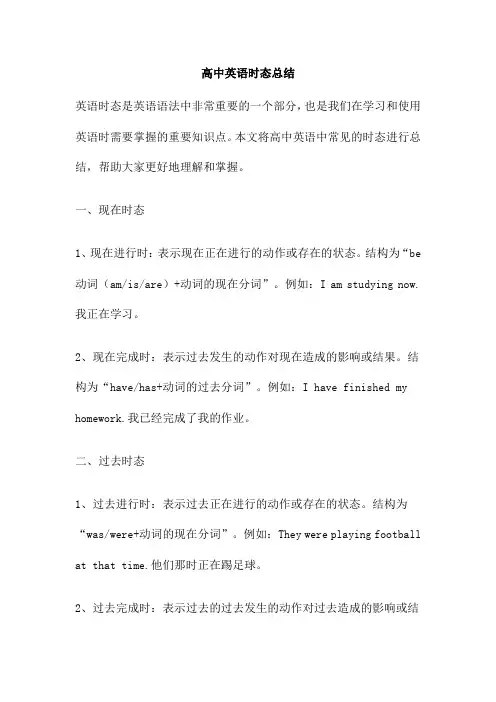
高中英语时态总结英语时态是英语语法中非常重要的一个部分,也是我们在学习和使用英语时需要掌握的重要知识点。
本文将高中英语中常见的时态进行总结,帮助大家更好地理解和掌握。
一、现在时态1、现在进行时:表示现在正在进行的动作或存在的状态。
结构为“be 动词(am/is/are)+动词的现在分词”。
例如:I am studying now.我正在学习。
2、现在完成时:表示过去发生的动作对现在造成的影响或结果。
结构为“have/has+动词的过去分词”。
例如:I have finished my homework.我已经完成了我的作业。
二、过去时态1、过去进行时:表示过去正在进行的动作或存在的状态。
结构为“was/were+动词的现在分词”。
例如:They were playing football at that time.他们那时正在踢足球。
2、过去完成时:表示过去的过去发生的动作对过去造成的影响或结果。
结构为“had+动词的过去分词”。
例如:They had finished their work before we arrived.他们在我们到达之前已经完成了他们的工作。
三、将来时态1、将来进行时:表示将来某个时间正在进行的动作或存在的状态。
结构为“will+be动词+动词的现在分词”。
例如:I will be studying at 9 o’clock tomorrow.我明天9点将会在学习。
2、将来完成时:表示将来某个时间已经完成的动作或达到的状态。
结构为“will+have+动词的过去分词”。
例如:I will have finished my homework by 10 o’clock tonight.我将在今晚10点之前完成我的作业。
以上是高中英语中常见的时态总结,希望能够帮助大家更好地理解和掌握英语时态。
需要注意的是,不同的时态有着不同的用法和结构,大家在使用时需要根据语境选择合适的时态。
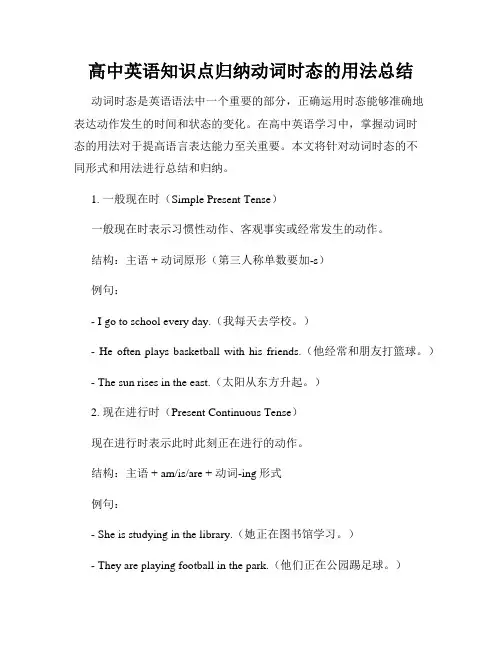
高中英语知识点归纳动词时态的用法总结动词时态是英语语法中一个重要的部分,正确运用时态能够准确地表达动作发生的时间和状态的变化。
在高中英语学习中,掌握动词时态的用法对于提高语言表达能力至关重要。
本文将针对动词时态的不同形式和用法进行总结和归纳。
1. 一般现在时(Simple Present Tense)一般现在时表示习惯性动作、客观事实或经常发生的动作。
结构:主语 + 动词原形(第三人称单数要加-s)例句:- I go to school every day.(我每天去学校。
)- He often plays basketball with his friends.(他经常和朋友打篮球。
)- The sun rises in the east.(太阳从东方升起。
)2. 现在进行时(Present Continuous Tense)现在进行时表示此时此刻正在进行的动作。
结构:主语 + am/is/are + 动词-ing形式例句:- She is studying in the library.(她正在图书馆学习。
)- They are playing football in the park.(他们正在公园踢足球。
)- What are you doing now?(你现在在做什么?)3. 一般过去时(Simple Past Tense)一般过去时表示过去某个时间发生的动作或状态。
结构:主语 + 动词过去式例句:- I finished my homework yesterday.(昨天我完成了作业。
)- He visited his grandparents last weekend.(他上周末去拜访了他的祖父母。
)- The film started at 7 p.m.(电影7点钟开始。
)4. 过去进行时(Past Continuous Tense)过去进行时表示过去某个时间正在进行的动作。
结构:主语 + was/were + 动词-ing形式例句:- They were watching TV when I called them.(我打电话给他们时,他们正在看电视。
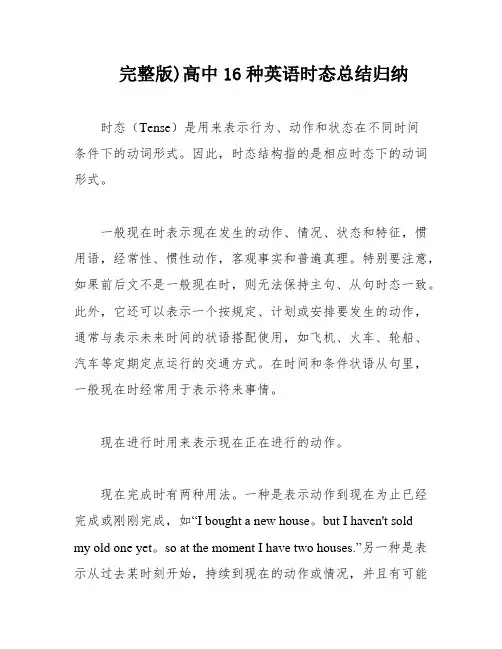
完整版)高中16种英语时态总结归纳时态(Tense)是用来表示行为、动作和状态在不同时间条件下的动词形式。
因此,时态结构指的是相应时态下的动词形式。
一般现在时表示现在发生的动作、情况、状态和特征,惯用语,经常性、惯性动作,客观事实和普遍真理。
特别要注意,如果前后文不是一般现在时,则无法保持主句、从句时态一致。
此外,它还可以表示一个按规定、计划或安排要发生的动作,通常与表示未来时间的状语搭配使用,如飞机、火车、轮船、汽车等定期定点运行的交通方式。
在时间和条件状语从句里,一般现在时经常用于表示将来事情。
现在进行时用来表示现在正在进行的动作。
现在完成时有两种用法。
一种是表示动作到现在为止已经完成或刚刚完成,如“I bought a new house。
but I haven't soldmy old one yet。
so at the moment I have two houses.”另一种是表示从过去某时刻开始,持续到现在的动作或情况,并且有可能会继续延续下去。
这时通常使用延续性动词,时间状语常用since加一个过去的时间点,或for加一段时间,或by加一个现在时间。
4.现在完成进行时 (have been doing)现在完成进行时用来描述一个从过去某一时间开始一直持续到现在的动作或状态,或将继续持续到未来。
例如:我们已经处理这个项目一个多月了,一直在进行中。
5.一般过去时一般过去时用来描述过去某个时间发生的动作或情况,或者过去的惯性动作。
例如:这位老人过去常常坐在公园的长椅上看着别人,一坐就是数个小时。
他以前总是每周看望他的母亲。
在句型中使用 "no sooner than"、"___"、"before"、"r to" 等连接词时,主句要求完成时。
例如:今天之前我从未见过那位教授。
在填空题中,句子中的动作已经持续了一段时间,并且需要进行修理。

高中英语知识点归纳动词的时态与语态总结动词的时态与语态是英语语法中的重要知识点。
时态指的是动词表示的动作或状态发生的时间,而语态则表示动词的主动或被动形式。
正确使用时态和语态对于理解和表达英语句子的意思至关重要。
本文将对常见的动词时态和语态进行归纳总结。
一、动词的时态1. 一般现在时(Simple Present)一般现在时表示经常性的动作、客观事实或普遍真理。
句子结构为主语 + 动词原形(第三人称单数在动词原形后加-s/-es)。
例如:- He goes to school every day.- Water boils at 100 degrees Celsius.- Cats like to eat fish.2. 现在进行时(Present Continuous)现在进行时表示现在正在进行或发生的动作。
句子结构为主语 + be 动词(am/is/are)+ 动词的ing形式。
例如:- She is watching TV.- They are talking on the phone.- We are studying for the exam.3. 一般过去时(Simple Past)一般过去时表示发生在过去的动作或状态。
句子结构为主语 + 动词过去式。
例如:- I visited my grandparents last weekend.- He studied English in high school.- They went to the concert together.4. 过去进行时(Past Continuous)过去进行时表示过去某个时间点正在进行或发生的动作。
句子结构为主语 + was/were + 动词的ing形式。
例如:- She was cooking dinner when I called her.- They were playing soccer at the park yesterday.- We were watching a movie when the power went out.5. 一般将来时(Simple Future)一般将来时表示将来某个时间要发生的动作。

高中时态语态总结一、时态总结英语中的时态分为简单时态、进行时态、完成时态和完成进行时态四种。
1. 简单时态表示现在、过去或将来的动作或状态,包括一般现在时、一般过去时和一般将来时。
- 一般现在时:主语+动词原形(第三人称单数要加-s或-es)例句:I study English every day.(我每天学习英语。
)- 一般过去时:主语+动词过去式例句:He played basketball yesterday.(他昨天打篮球。
)- 一般将来时:主语+will/shall+动词原形例句:We will go to the park tomorrow.(我们明天去公园。
)2. 进行时态表示正在进行的动作,包括现在进行时和过去进行时。
- 现在进行时:主语+be动词+现在分词例句:She is watching TV now.(她正在看电视。
)- 过去进行时:主语+was/were+现在分词例句:They were playing football at that time.(那个时间他们正在踢足球。
)3. 完成时态表示已经完成的动作,包括现在完成时和过去完成时。
- 现在完成时:主语+have/has+过去分词例句:I have finished my homework.(我已经完成了我的作业。
)- 过去完成时:主语+had+过去分词例句:He had already left when I arrived.(我到达时他已经离开了。
)4. 完成进行时态表示过去一段时间一直在进行的动作,包括现在完成进行时和过去完成进行时。
- 现在完成进行时:主语+have/has been+现在分词例句:She has been studying English for three years.(她已经学习英语三年了。
)- 过去完成进行时:主语+had been+现在分词例句:He had been working for five hours when he stopped.(他停止工作的时候已经工作了五个小时了。

高中英语时态语态总结时态是英语中非常重要的语法项目,它直接关系到句子的表达准确性和连贯性。
在学习英语的过程中,时态的掌握是至关重要的一环。
本文将对高中英语中常见的时态和语态进行总结,希望能够帮助同学们更好地掌握这一知识点。
一、一般现在时。
一般现在时表示经常性或习惯性的动作,或者客观真理。
它的构成是主语+动词原形(第三人称单数要加-s)。
二、一般过去时。
一般过去时表示过去某个时间发生的动作或状态。
它的构成是主语+动词过去式。
三、一般将来时。
一般将来时表示将来某个时间要发生的动作或状态。
它的构成是主语+will/shall+动词原形。
四、现在进行时。
现在进行时表示现在进行的动作。
它的构成是主语+be动词+动词-ing形式。
五、过去进行时。
过去进行时表示过去某个时间正在进行的动作。
它的构成是主语+was/were+动词-ing形式。
六、现在完成时。
现在完成时表示过去某个时间开始,一直持续到现在的动作或状态。
它的构成是主语+have/has+动词过去分词。
七、过去完成时。
过去完成时表示过去某个时间之前已经完成的动作或状态。
它的构成是主语+had+动词过去分词。
八、一般将来完成时。
一般将来完成时表示将来某个时间之前已经完成的动作或状态。
它的构成是主语+will/shall+have+动词过去分词。
九、被动语态。
被动语态表示主语是动作的承受者。
它的构成是be动词+动词过去分词。
十、情态动词。
情态动词包括can, could, may, might, must, shall, should, will, would等。
它们用来表示说话人的态度、情感或推测。
总结,时态和语态是英语语法中的重要内容,它们直接关系到句子的表达准确性。
在学习过程中,我们要多加练习,多加总结,才能够真正掌握好这一知识点。
希望本文的总结能够帮助大家更好地理解和掌握高中英语中的时态和语态。
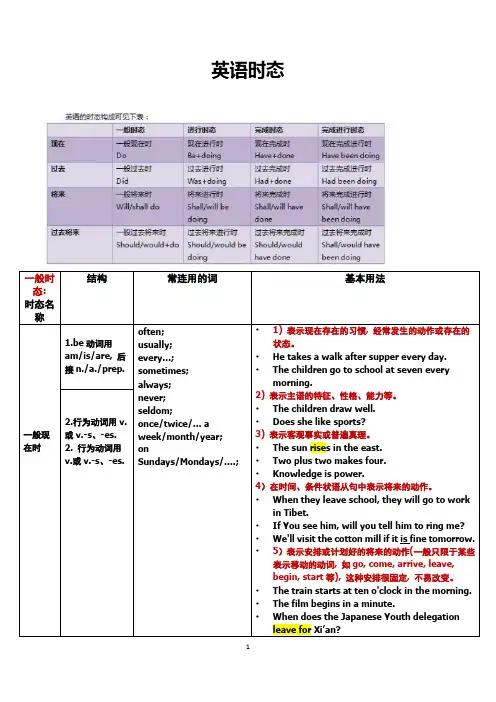
英语时态一般时态:时态名称结构常连用的词基本用法一般现在时1.be动词用am/is/are, 后接n./a./prep.often;usually;every…;sometimes;always;never;seldom;once/twice/… aweek/month/year;onSundays/Mondays/….;•1) 表示现在存在的习惯, 经常发生的动作或存在的状态。
•He takes a walk after supper every day.•The children go to school at seven everymorning.2)表示主语的特征、性格、能力等。
•The children draw well.•Does she like sports?3) 表示客观事实或普遍真理。
•The sun rises in the east.•Two plus two makes four.•Knowledge is power.4)在时间、条件状语从句中表示将来的动作。
•When they leave school, they will go to workin Tibet.•If You see him, will you tell him to ring me?•We'll visit the cotton mill if it is fine tomorrow.•5)表示安排或计划好的将来的动作(一般只限于某些表示移动的动词, 如go, come, arrive, leave,begin, start等), 这种安排很固定, 不易改变。
•The train starts at ten o'clock in the morning.•The film begins in a minute.•When does the Japanese Youth delegationleave for Xi’an?2.行为动词用v.或v.-s、-es.2. 行为动词用v.或v.-s、-es.1.________ a concert next Saturday?2. A.There will be B.Will there be C.There can be D.There are3.It’s good t o see you again, Agnes.— This has been our first chance to visit since from Iran.4. A.you return B.you returned C.you have returned D.returning5.If it ________ tomorrow, we’ll go roller-skating.A.isn’t rainB.won’t rainC.doesn’t rainD.doesn’t fine4.The reporter said that the UFO ___ east to west when he saw it.A.was travelingB.traveledC.had been travelingD.was to travel5.Sorry, I can’t open the door, for I the key to it.A.lostB.loseC.had lostD.have lost6.“What ' s the matter, Ali? You look sad.”“Oh, nothing much.As a matter of fact, I ___ of my friends back home.”A.just thoughtB.have just been thinkingC.was just thinkingD.have just thought7.—Did you expect Frank to come to the party? —No, but I had hoped .A.him comingB.him to comeC.that he comesD.that he would come8.—Bob must be very wealthy.—Yes, he more in one day than I do in a week.A.has been earnedB.had earnedC.earnsD.has earned9.I first met Lisa three years ago.She ___ at a radio shop at the time.A.has workedB.was workingC.had been workingD.had worked10.She _____her keys in the office so she had to wait until her husband ____home.A has left; comesB had left; would comeC had left; cameD left; had come11.Zhao Lan ______already ______in this school for two years.12.A.was ; studying B.will ; study C.has ; studied D.are ; studying---Mr Gorden asked me to remind you of the meeting this afternoon .Don’t forget it !---OK.I ______ .13.A.won't B.don't C.will D.do14.When I reached home, my parents __________their supper.15.A.are having B.have already had C.have had D.had already had16.She __________in this school ________the past ten years.A.was teaching, sinceB.had been teaching, since17.C.would teach, for D.has been teaching, forI first met Tom 10 years ago.He ______ in a radio factory at that time.18.A.had worked B.has worked C.was working D.has been working19.--- What ______ when I phoned you?--- I ______ my work, and I wanted to go out.A.have you done; finishedB.were you doing; have finished20.C.did you do; had just finished D.were you doing; had just finished21.I used to drink a lot of tea but these days I ______ coffee.22.A.prefer B.preferred C.had preferred D.am preferringJim talked for about half an hour yesterday.Never ______ him talk so much.23.A.I heard B.did I hear C.I had heard D.had I heard24.He ___ articles for our wall-newspaper these three years, and he ____ about fortyarticles.A.has been writing; has writtenB.had been writing; wrote25.C.is writing; has been writing D.has written; has written26.When he was alive, the old scientist used to say that knowledge ______ from practice andhe gained his experience by doing a lot of practical work.27.A.was coming B.had come es D.would come28.--- How are you planning to travel to Shanghai?--- I ______ yet, but I ______ taking a train.A.didn’t decide; am consideringB.haven’t decided; consider29.C.haven’t decided; am considering D.hadn’t decided; have considered30.--- Who’s the man over there?--- It’s Jack.--- Oh? ______ in Italy.A.I think he’sB.I’ve thought he’s been31.C.I thought he was D.I’d thought he’d beenI thought Jim would say something about his school report, but he ______ it.32.A.doesn’t mention B.hadn’t mentioned C.didn’t mention D.hasn’t mentioned33.—How long ________ each other before they ________ married?—For about a year.A.have they known; getB.did they know; getC.do they know; are going to getD.had they known; gotWe would like to go and thank him ourselves, but we ________ out his address yet,A.haven’t foundB.hadn’t foundC.didn’t findD.don’t find34.Shirley ________ a book about China last year but I don’t know whether she has finished.A.has writtenB.wroteC.had writtenD.was writing35.—Do you know when Tom ________ from abroad?—Perhaps it will be a long time before he ________ back.A.will come; will comees; will comeC.will come; comeses; comesThe pen I ________ I ________ is on my desk, right under my nose.A.think; lostB.thought; had lostC.think; had lostD.thought; lostHowever hard you ________, you will never succeed in pleasing her.A.tryB.will tryC.should tryD.would try36.By this time tomorrow we ________ the machine.A.have repairedB.shall have repairedC.will repairD.would repair37.I ________ the room to be empty but found it occupied.A.had thoughtB.have thoughtC.didn’t thinkD.was thinking。
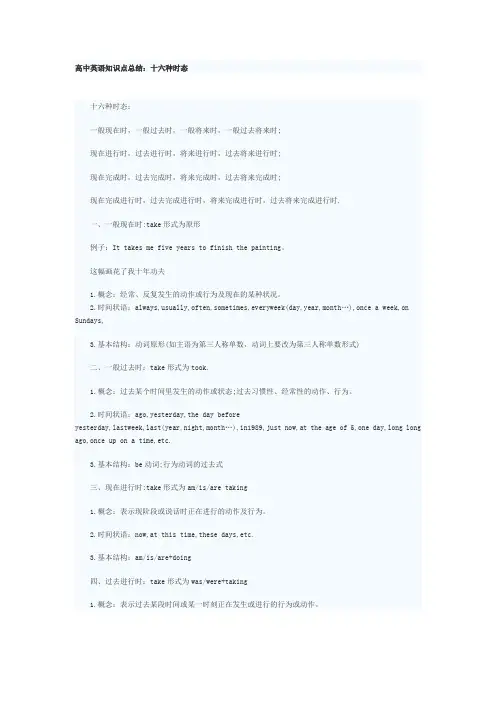
高中英语知识点总结:十六种时态十六种时态:一般现在时,一般过去时,一般将来时,一般过去将来时;现在进行时,过去进行时,将来进行时,过去将来进行时;现在完成时,过去完成时,将来完成时,过去将来完成时;现在完成进行时,过去完成进行时,将来完成进行时,过去将来完成进行时.一、一般现在时:take形式为原形例子:It takes me five years to finish the painting。
这幅画花了我十年功夫1.概念:经常、反复发生的动作或行为及现在的某种状况。
2.时间状语:always,usually,often,sometimes,everyweek(day,year,month…),once a week,on Sundays,3.基本结构:动词原形(如主语为第三人称单数,动词上要改为第三人称单数形式)二、一般过去时:take形式为took.1.概念:过去某个时间里发生的动作或状态;过去习惯性、经常性的动作、行为。
2.时间状语:ago,yesterday,the day beforeyesterday,lastweek,last(year,night,month…),in1989,just now,at the age of 5,one day,long long ago,once up on a time,etc.3.基本结构:be动词;行为动词的过去式三、现在进行时:take形式为am/is/are taking1.概念:表示现阶段或说话时正在进行的动作及行为。
2.时间状语:now,at this time,these days,etc.3.基本结构:am/is/are+doing四、过去进行时:take形式为was/were+taking1.概念:表示过去某段时间或某一时刻正在发生或进行的行为或动作。
2.时间状语:at this time yesterday,at that time或以when引导的谓语动词是一般过去时的时间状语等。
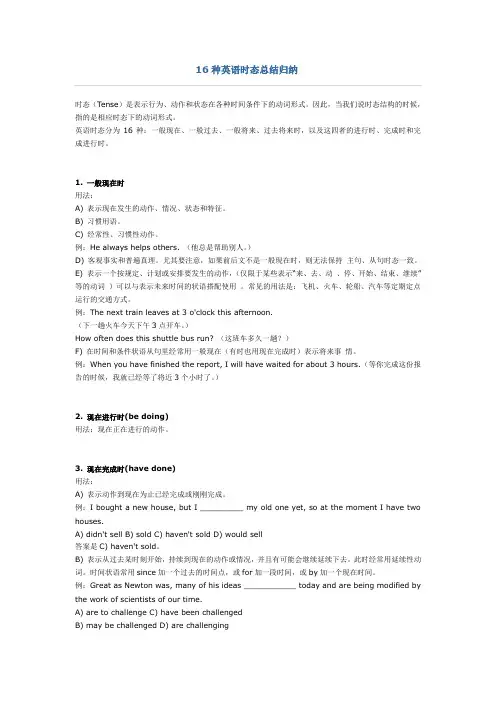
时态(Tense)是表示行为、动作和状态在各种时间条件下的动词形式。
因此,当我们说时态结构的时候,指的是相应时态下的动词形式。
英语时态分为16种:一般现在、一般过去、一般将来、过去将来时,以及这四者的进行时、完成时和完成进行时。
1. 一般现在时用法:A) 表示现在发生的动作、情况、状态和特征。
B) 习惯用语。
C) 经常性、习惯性动作。
例:He always helps others. (他总是帮助别人。
)D) 客观事实和普遍真理。
尤其要注意,如果前后文不是一般现在时,则无法保持主句、从句时态一致。
E) 表示一个按规定、计划或安排要发生的动作,(仅限于某些表示“来、去、动、停、开始、结束、继续”等的动词)可以与表示未来时间的状语搭配使用。
常见的用法是:飞机、火车、轮船、汽车等定期定点运行的交通方式。
例:The next train leaves at 3 o'clock this afternoon.(下一趟火车今天下午3点开车。
)How often does this shuttle bus run? (这班车多久一趟?)F) 在时间和条件状语从句里经常用一般现在(有时也用现在完成时)表示将来事情。
例:When you have finished the report, I will have waited for about 3 hours.(等你完成这份报告的时候,我就已经等了将近3个小时了。
)2. 现在进行时(be doing)用法:现在正在进行的动作。
3. 现在完成时(have done)用法:A) 表示动作到现在为止已经完成或刚刚完成。
例:I bought a new house, but I _________ my old one yet, so at the moment I have two houses.A) didn't sell B) sold C) haven't sold D) would sell答案是C) haven't sold。
高中16种英语时态总结归纳1. Simple Present Tense:- Used for regular actions or habits, and general truths.- Form: Base form of the verb (e.g. I go, he/she/it goes).2. Present Continuous Tense:- Used to describe actions happening at the moment of speaking, or for future arrangements.- Form: am/is/are + present participle (e.g. I am writing, he/she/it is reading).3. Present Perfect Tense:- Used for actions that happened at an unspecified timein the past, and have relevance to the present.- Form: has/have + past participle (e.g. I have seen,he/she/it has done).4. Present Perfect Continuous Tense:- Used for actions that started in the past and continue into the present, and emphasize duration.- Form: has/have been + present participle (e.g. I have been waiting, he/she/it has been working).5. Simple Past Tense:- Used for actions that started and finished at aspecific time in the past.- Form: Past form of the verb (e.g. I went, he/she/it played).6. Past Continuous Tense:- Used to emphasize the duration of an action in the past, or for two actions happening simultaneously in the past.- Form: was/were + present participle (e.g. I was sleeping, he/she/it was writing).7. Past Perfect Tense:- Used to describe an action that happened before another action in the past.- Form: had + past participle (e.g. I had seen, he/she/it had finished).8. Past Perfect Continuous Tense:- Used to show the duration of an action that happened before another action in the past.- Form: had been + present participle (e.g. I had been waiting, he/she/it had been studying).9. Simple Future Tense:- Used to talk about actions that will happen in the future.- Form: will/shall + base form of the verb (e.g. I will go, he/she/it will eat).10. Future Continuous Tense:- Used to describe actions that will be ongoing at a specific time in the future.- Form: will/shall be + present participle (e.g. I will be waiting, he/she/it will be working).11. Future Perfect Tense:- Used for actions that will be completed before another action in the future.- Form: will have + past participle (e.g. I will have finished, he/she/it will have left).12. Future Perfect Continuous Tense:- Used to emphasize the duration of an action that will be completed before another action in the future.- Form: will have been + present participle (e.g. I will have been waiting, he/she/it will have been studying).13. Present Unreal Conditional:- Used to talk about hypothetical situations in the present or future, expressing results that are unlikely or impossible.- Form: if + simple past, would + base form (e.g. If I were rich, I would travel the world).14. Past Unreal Conditional:- Used to talk about hypothetical situations in the past, expressing results that didn't happen.- Form: if + past perfect, would have + past participle(e.g. If I had studied harder, I would have passed the test).15. Mixed Tenses:- Used to describe actions that happen at the same time but in the past and present or future.- Form: Mix of different tenses.16. Future Time Clauses:- Used to indicate two actions happening in the future, with the main clause in the future and the time clause in the present.- Form: Present tense in the time clause, will/shall or other future tense in main clause (e.g. When I am 25, I will have graduated).。
高中英语时态总结高中英语时态总结一、一般现在时态(Simple Present Tense)1. 表示现在正在发生的动作或状态。
例:I go to school every day(我每天都去上学)。
2. 表示经常性的动作或状态。
例:She always brushes her teeth before going to bed(她睡觉前总是刷牙)。
3. 表示真理、普遍事实或科学道理。
例:The sun rises in the east(太阳从东方升起)。
4. 用于表示将来的时间状语从句中,表示计划、安排或打算。
例:He will go to the cinema if he finishes his homework(如果他完成作业的话,他将去电影院)。
二、现在进行时态(Present Continuous Tense)1. 表示现在正在进行的动作。
例:She is reading a book now(她现在正在读书)。
2. 表示计划或安排好的即将要发生的动作。
例:We are going to the park this weekend(我们这个周末要去公园)。
三、一般过去时态(Simple Past Tense)1. 表示过去某个时间发生的动作或状态。
例:We went to the beach last summer(去年夏天我们去了海滩)。
2. 表示过去的习惯或经常发生的动作。
例:When I was a child, I played football every day(我小的时候,我每天都踢足球)。
四、过去进行时态(Past Continuous Tense)1. 表示过去某个时间正在进行的动作。
例:I was watching TV when he called(他打电话的时候,我正在看电视)。
2. 表示过去同时发生的两个或多个动作。
例:While mom was cooking, dad was reading a book(妈妈在做饭的时候,爸爸在看书)。
高中英语十大时态一、一般现在时:1.结构:主语 + 动词原形(当主语是第三人称单数时,动词需加“s”或“es”);be 动词根据主语不同用“am/is/are”。
2.用法:●表示现在的情况、状态或特征。
例如:“He is a student.”(他是一个学生。
)●表示经常性、习惯性动作。
例如:“She often goes to school bybike.”(她经常骑自行车上学。
)●表示客观事实和普遍真理。
例如:“The earth moves around thesun.”(地球绕着太阳转。
)●表示按规定、计划或安排要发生的动作,常用于飞机、火车、轮船等定期定点运行的交通方式。
例如:“The next flight takes off at 8 o'clock tomorrow morning.”(下一趟航班明天早上8点起飞。
)二、现在进行时:1.结构:主语 + am/is/are + 动词的现在分词。
2.用法:●表示此时此刻正在发生的事情。
例如:“They are having a meetingnow.”(他们现在正在开会。
)●表示目前一段时间内一直在做的事情,但不一定此时此刻正在做。
例如:“I am learning French this semester.”(这学期我在学法语。
)●现在进行时可以表示将来的含义,通常是一些瞬间动词的进行时表将来,或者持续动词的进行时有将来的时间状语或语境时表将来。
例如:“I am leaving for Beijing tomorrow.”(我明天要去北京。
)三、现在完成时:1.结构:主语 + have/has + 动词的过去分词。
2.用法:●表示动作到现在为止已经完成或刚刚完成,强调对现在产生的影响。
例如:“I have finished my homework, so I can watch TV now.”(我已经完成作业了,所以现在可以看电视了。
高中英语时态总结在高中英语学习中,时态是一个至关重要的语法知识点。
掌握好时态,不仅能让我们更准确地表达自己的意思,还能帮助我们更好地理解英语文章。
下面就为大家详细总结一下高中英语中常见的时态。
一、一般现在时一般现在时表示经常发生的动作或存在的状态。
其构成是:主语+动词原形(当主语是第三人称单数时,动词要加“s”或“es”)。
例如:I go to school every day(我每天上学。
)He likes playing basketball(他喜欢打篮球。
)一般现在时的用法主要有以下几种:1、表示经常性或习惯性的动作,常与 often, always, usually, sometimes 等时间状语连用。
2、表示客观事实或普遍真理。
3、用于时间、条件、方式、让步等状语从句中,表示将来的动作。
二、一般过去时一般过去时表示过去某个时间发生的动作或存在的状态。
其构成是:主语+动词的过去式。
例如:I played football yesterday(我昨天踢足球了。
)一般过去时的用法:1、表示过去某个特定时间发生的动作或存在的状态,常与表示过去的时间状语连用,如 yesterday, last week, in 1998 等。
2、表示过去一段时间内经常或反复发生的动作。
三、一般将来时一般将来时表示将来要发生的动作或存在的状态。
其构成有多种形式,常见的有:“will +动词原形”和“be going to +动词原形”。
例如:I will go to Beijing next week(我下周将去北京。
)She is going to have a party tomorrow(她明天将举办一个派对。
)一般将来时的用法:1、表示将来要发生的动作或存在的状态。
2、表示将来的打算、计划或准备做某事。
四、现在进行时现在进行时表示正在进行的动作。
其构成是:主语+ be(am/is/are)+现在分词。
例如:I am reading a book now(我现在正在读一本书。
高中英语时态语法总结归纳英语时态是表示动作发生时间的一种语法形式,在高中英语学习中扮演着重要的角色。
正确使用时态可以使语言表达更加准确和流畅。
本文将对高中英语常用的时态进行总结归纳,以帮助学生更好地掌握时态的用法。
一、一般现在时 (Simple Present Tense)一般现在时用于表示经常性的动作、客观事实、真理、习惯和固定时间表等。
1. 结构:主语 + 动词原形(单数加s或es)+ 其他2. 示例:- He plays soccer every weekend.(他每个周末都踢足球。
)- Water boils at 100 degrees Celsius.(水在100摄氏度时沸腾。
)- I usually go to bed at 10 o'clock.(我通常十点钟上床睡觉。
)二、一般过去时 (Simple Past Tense)一般过去时用于表示过去某个时间发生的动作或状态。
1. 结构:主语 + 动词过去式(一般过去时动词过去式的变化规则多样)2. 示例:- They went to the park yesterday.(他们昨天去了公园。
)- She watched a movie last night.(她昨晚看电影了。
)- I played the guitar when I was young.(我年轻时弹吉他。
)三、一般将来时 (Simple Future Tense)一般将来时用于表示将来某个时间或情况下发生的动作或状态。
1. 结构:主语 + will/shall + 动词原形2. 示例:- We will study English tomorrow.(我们明天将学习英语。
)- He shall help you with your assignment.(他将帮助你完成作业。
)- They won't go to the party this weekend.(他们这个周末不会去参加派对。
高中英语语法八个时态归纳总结英语语法中的时态是指动词形态变化来表示不同的时间状态。
在英语语法中,共有八个时态,包括一般现在时、一般过去时、一般将来时、现在进行时、过去进行时、过去将来进行时、现在完成时和过去完成时。
这里将对这八个时态进行归纳总结,以帮助高中学生更好地理解和运用这些时态。
1. 一般现在时(Simple Present)一般现在时表示经常性、习惯性的动作或真理,也用于表示主语在现在的状态或职业。
例句:- I eat breakfast every morning.(我每天早上吃早餐。
)- The sun rises in the east.(太阳从东方升起。
)- She works as a teacher.(她是一名教师。
)2. 一般过去时(Simple Past)一般过去时表示过去某个时间发生或存在的动作或状态。
例句:- I studied English yesterday.(昨天我学习了英语。
)- They went to the beach last summer.(他们去年夏天去了海滩。
)- She lived in London for five years.(她在伦敦住了五年。
)3. 一般将来时(Simple Future)一般将来时表示将来某个时间要发生的动作或存在的状态。
例句:- I will go shopping tomorrow.(我明天要去购物。
)- They are going to visit their grandparents next month.(他们下个月要去看望他们的祖父母。
)- She is going to study abroad after graduation.(她毕业后打算出国留学。
)4. 现在进行时(Present Continuous)现在进行时表示现在正在进行的动作或状态。
例句:- I am reading a book right now.(我现在正在读一本书。
高中英语时态知识点总结导读:我根据大家的需要整理了一份关于《高中英语时态知识点总结》的内容,具体内容:时态是英语学习过程当中绕不开的语法。
要学好英语,除了单词,还要学好时态。
下面由我给你带来关于,希望对你有帮助!英语时态知识点总结1一般现在时①表示客观事实或普通真理(不...时态是英语学习过程当中绕不开的语法。
要学好英语,除了单词,还要学好时态。
下面由我给你带来关于,希望对你有帮助!英语时态知识点总结1一般现在时①表示客观事实或普通真理(不受时态限制)The geography teacher told us the earth moves around the sun. Water boils at 100oC.②表示现状、性质、状态时多用系动词或状态动词;表示经常或习惯性的动作,多用动作动词,且常与表频率的时间状语连用。
Ice feels cold.We always care for each other and help each other.③表示知觉、态度、感情、某种抽象的关系或概念的词常用一般现在时:see、hear、smell、taste、feel、notice、agree、believe、like、hate、want、think、belong seem等。
如:I know what you mean.Smith owns a car and a house.All the students here belong to No.1 Middle School.④在时间、条件状语从句中常用一般现在时代替将来时。
但要注意由if 引导的条件状语从句中可以用shall或will表"意愿",但不表示时态。
If you will accept my invitation and come to our party, my family will be pleased.如果你愿意接受并参加我们的舞会,我的家人会非常高兴。
⑤少数用于表示起止的动词如come、go、leave、arrive、fly、return、start、begin、pen、close、end、stop等常用一般现在时代替将来时,表示一个按规定、计划或安排要发生的动作。
当be表示根据时间或事先安排,肯定会出现的状态,只用一般现在时。
The shop closes at 11:00 p.m. every day.Tomorrow is Wednesday.英语时态知识点总结2一般过去时①一般过去时的基本用法:表示过去的事情、动作或状态常与表示过去具体的时间状语连用(或有上下文语境暗示);用于表达过去的习惯;表示说话人原来没有料到、想到或希望的事通常用过去式。
如:I met her in the street yesterday.I once saw the famous star here.They never drank wine.I thought the film would be interesting,but it isnt.②如果从句中有一个过去的时间状语,尽管从句中的动作先于主句发生,但从句中的谓语动词连用过去式。
如:He told me he read an interesting novel last night.③表示两个紧接着发生的动作,常由以下词语连接,用一般过去时。
如:but, and, when, as soon as, immediately, the moment, the minute。
The moment she came in, she told me what had happened to her. He bought a watch but lost it.④常用一般过去时的句型:Why didnt you / I think of that?I didnt notice it.I forgot to tell you I had been there with my brother before.I didnt recognize him.英语时态知识点总结3一般将来时①表示未来的动作或状态常用will / shall + 动词(常与表示将来的时间状语边用如tomorrow、next week等)。
②表示一种趋向或习惯动作。
Well die without air or water.③表示趋向行为的动词如come、go、start、begin、leave等词常用进行时的形式表示将来时。
④be going to与will / shall, be to do, be about to do用法及区别:be going to 表示现在打算在最近或将来要做某事,这种打算往往经过事先考虑,甚至已做了某种准备;shall / will do表示未事先考虑过,即说话时临时作出的决定。
be going to 表将来,不能用在条件状语从句的主句中;而will则能,表意愿。
如:If it is fine, well go fishing.(正确)If it is fine, we are going to go fishing.(错误)be to do sth.表按计划、安排即将发生的动作,还可表示吩咐、命令、禁止,可能性等。
A meeting is to be held at 3:00 oclock this afternoon.be about to do sth.表示"即可,就要",后面不能接时间状语或状语从句。
Autumn harvest is about to start.英语时态知识点总结4现在进行时①表示说话时正在发生着的一个动作;表示现阶段但不一定是发生在讲话时;表近期特定的安排或计划;go、come等起止动作可用进行时代替将来时。
如:It is raining now.He is teaching English and learning Chinese.I am meeting Mr. Wang tonight.We are leaving on Friday.At six I am bathing the baby.(I start bathing the bady before six.) The girl is always talking loud in public.(与always、often等频度副词连用,表经常反复的行动或某种感情色彩)②下面四类动词不宜用现在进行时。
(A)表示心理状态、情感的动作:like, love, hate, care, remember, believe, want, mind, wish, agree,mean, need。
(B)表存在的状态的动词:appear, exist, lie, remain, seem belong to, depend on。
(C)表示一时性动作的动词:allow, accept, permit, promise, admit, complete。
(D)表示感官的动词:see, hear, notice, feel, smell, sound, taste, look。
英语时态知识点总结5过去完成时①常用过去完成时的几种情况:(A)在by、by the end、by the time、until、before、since后接表示过去某一时间的短语或从句以前发生的动作。
如:By the end of last year, we had produced 20,000 cars. The train had left before we reached the station. (B)表示曾实现的希望、打算、意图、诺言等。
常用had hoped / planned / meant / intended/ though / wanted / expected等或用上述动词过去式接不定式完成式表示即:hoped / planned ... + to have done。
(C)"时间名词 + before"在句子中作状语,谓语动词用过去完成时;"时间名词 + ago"在句中作状语,谓语动词用一般过去式。
如:He said his first teacher had died at least 10 years before. Xiao Hua left school 3 years ago.(D)表示"一......就"的几个句型:Hardly / No sooner / Scarcely had + 主语 + 过去分词 + when / than / before + 一般过去时。
如:We had no sooner been seated than the bus started. = No sooner had we been seated than the bus started.②在before或after引导的时间状语从句中用一般过去时态代替过去完成时。
After he (had)left the room, the boss came in.We arrived home before it snowed.英语时态知识点总结6过去将来时参照一般将来时对比:用would do、was / were going to do sth.表过去将来;come、go、leave等过去进行时表过去将来时;was / were to do sth.和was / were about to do sth.表过去将来。
英语时态知识点总结7过去进行时①过去某一时刻正在进行的动作或某一阶段内发生或频繁发生。
②某一动作发生时另一动作正在发生,其中一个在由when或while引导的时间状语从句中。
英语时态知识点总结8现在完成时①现在完成时除可以和for、since引导的状语连用外,还可以和下面的介词短语连用:during / in /over the last(past)few years (months, weeks)、in recent years等。
②下列句型中常用现在完成时It is (has been) + 一段时间 + since从句This(That / It)is the first(second...)time that + 完成时This(That / It)is the only ... + that + 完成时This(that / It)is the best / finest / most interesting ... + that 从句 + 完成时③在时间或条件状语从句中,现在完成时可以代替一般将来时。